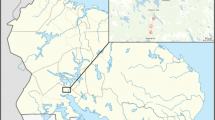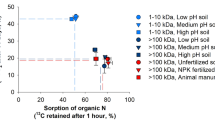Abstract
Thymidine and leucine incorporation into macromolecules of soil bacteria extracted by homogenization-centrifugation were measured after size-fractionation of the bacterial suspension through different sized filters (1.0, 0.8, 0.6, 0.4 μm). The specific thymidine incorporation rate was highest for the unfiltered and 1.0 μm filtered suspensions (approximately 10 × 10−21 mol thymidine bacteria−1 h−1), but decreased to 1.39 × 10−21 mol bacteria−1 h−1 for bacteria passing the 0.4 μm filter. The proportion of culturable bacteria (percent colony forming units/acridine orange direct counts) also decreased with bacterial cell size from 5.0% for the unfiltered bacterial suspension to 0.8% in the 0.4 µm filtrate. A strong linear correlation (r 2 = 0.995) was found between the specific thymidine incorporation rate and the proportion of culturable bacteria. Leucine incorporation gave similar results to the thymidine incorporation. No effects of cell size on the degree of isotope dilution or unspecific labeling of other macromolecules were found either for the thymidine or the leucine incorporation technique. These data indicate that small bacteria, although more numerous than larger ones, not only constitute a smaller proportion of the soil bacterial biomass than larger bacteria, but also contribute to a lesser degree to carbon transformations in soil.
Similar content being viewed by others
References
Azam F, Hodson RE (1981) Multiphasic kinetics for D-glucose uptake by assemblages of natural marine bacteria. Mar Ecol Prog Ser 6:213–222
Bååth E (1992) Thymidine incorporation into macromolecules of bacteria extracted from soil by homogenization-centrifugation. Soil Biol Biochem 24:1157–1165
Bååth E (1993) Measurement of protein synthesis of soil bacterial assemblages using the leucine incorporation technique. Biol Fert Soils 17:147–153
Bååth E, Arnebrant K (1994) Bacterial growth rates and tolerance changes to pH in limed and ash treated forest soils. Soil Biol Biochem 26 (in press)
Bae HC, Casida LE (1973) Responses of indigenous microorganisms to soil incubation as viewed by transmission electron microscopy of cell thin sections. J Bact 113:1462–1473
Bae HC, Cota-Robles EH, Casida LE (1972) Microflora of soil as viewed by transmission electron microscopy. Appl Microbiol 23:637–648
Bakken LR (1985) Separation and purification of soil bacteria by density gradient centrifugation. Appl Environ Microbiol 49:1482–1487
Bakken LR, Olsen RA (1987) Dwarf cells in soil. A result of starvation of “normal” bacteria, or a separate population? In: Perspectives in microbial ecology. Megusar F, Gantar, M (eds), Slovene Society of Microbiology, Ljubljana, pp 561–566
Bakken LR, Olsen RA (1987) The relationship between cell size and viability of soil bacteria. Microb Ecol 13:103–114
Bakken LR, Olsen RA (1989) DNA-content of soil bacteria of different cell size. Soil Biol Biochem 21:789–793
Bird DF, Kalff J (1993) Protozoan grazing and the size-activity structure of limnetic bacterial communities. Can J Fish Aquatic Sci 50:370–380
Breland TA, Bakken LR (1991) Microbial growth and nitrogen immobilization in the root zone of barley (Hordeum vulgare L.), Italian ryegrass (Lolium multiflorum Lam.), and white clover (Trifolium repens L.). Biol Fert Soils 12:154–160
Christensen H (1993) Conversion factors for the thymidine incorporation technique estimated with bacteria in pure culture and on seedling roots. Soil Biol Biochem 25:1085–1096
Christensen H, Jakobsen I (1993) Reduction of bacterial growth by a vesicular-arbuscular fungus in the rhizosphere of cucumber (Cucumis sativus L.). Biol Fert Soils 15:253–258
Clarholm M, Rosswall T (1980) Biomass and turnover of bacteria in a forest soil and a peat. Soil Biol Biochem 12:49–57
Faegri A, Lid Torsvik V, Goksöyr J (1977) Bacterial and fungal activities in soil: separation of bacteria and fungi by a rapid fractionated centrifugation technique. Soil Biol Biochem 9:105–112
Fry JC, Zia T (1982) Viability of heterotrophic bacteria in freshwater. J Gen Microbiol 128:2841–2850
Hattori T (1982) Analysis of plate count data of bacteria in natural environments. J Gen Appl Microbiol 28:13–22
Hattori T (1985) Kinetics of colony formation of bacteria. Rep Inst Agric Tohoku Univ 34:1–36
Ingraham LJ, Maalöe O, Neidhardt FC (1983) Growth of the bacterial cell. Sinauer Associates, Inc., Sunderland, Mass.
Jörgensen NOG (1992) Incorporation of [3H]leucine and [3H]valine into protein of freshwater bacteria: uptake kinetics and intracellular isotope dilution. Appl Environ Microbiol 58:3638–3646
Krambeck C, Krambeck H-J, Overbeck J (1981) Microcomputer assisted biomass determination of plankton bacteria on scanning electron micrographs. Appl Environ Microbiol 42:142–149
Letarte Y, Pinel-Alloul B (1991) Role du bactërioplankton en milieu lacustre pélagique: prépondérance des plus grosses bactéries. Can J Microbiol 37:465–473
Letarte Y, Pinel-Alloul B (1991) Relationships between bacterioplankton production and limnological variables: necessity of bacterial size considerations. Limnol Oceanogr 36:1208–1216
Letarte Y, Hansen H-J, Söndergaard M, Pinel-Alloul B (1992) Production and abundance of different bacterial size-classes: relationships with primary production and chlorophyll concentration. Arch Hydrobiol 126:15–26
Lund V, Goksbyr J (1980) Effects of water fluctuations on microbial mass and activity in soil. Microb Ecol 6:115–123
Lundgren B (1984) Size classification of soil bacteria: effects on microscopically-estimated biovolumes. Soil Biol Biochem 16:283–284
Olsen RA, Bakken LR (1987) Viability of soil bacteria: optimization of the plate-counting technique. Microb Ecol 13:59–74
Pollard PC, Moriarty DJW (1984) Validity of the tritiated thymidine method for estimating bacterial growth rates: measurement of isotope dilution during DNA synthesis. Appl Environ Microbiol 48:1076–1083
Riemann B, Söndergaard M (1984) Measurement of diel rates of bacterial secondary production in aquatic environments. Appl Environ Microbiol 47:632–638
Schnürer J, Clarholm M, Rosswall T (1985) Microbial biomass and activity in an agricultural soil with different organic matter contents. Soil Biol Biochem 17:611–618
Servais P, Garnier J (1993) Contribution of heterotrophic bacterial production to the carbon budget of the river Seine (France). Microb Ecol 25:19–33
Simon M (1987) Biomass and production of small and large free-living and attached bacteria in Lake Constance. Limnol Oceanogr 32:591–607
Simon M (1988) Growth characteristics of small and large free-living and attached bacteria in Lake Constance. Microb Ecol 15:151–163
Simon M, Azam F (1989) Protein content and protein synthesis rates of planktonic marine bacteria. Mar Ecol Prog Ser 51:201–213
Author information
Authors and Affiliations
Rights and permissions
About this article
Cite this article
Bååth, E. Thymidine and leucine incorporation in soil bacteria with different cell size. Microb Ecol 27, 267–278 (1994). https://doi.org/10.1007/BF00182410
Received:
Revised:
Issue Date:
DOI: https://doi.org/10.1007/BF00182410




